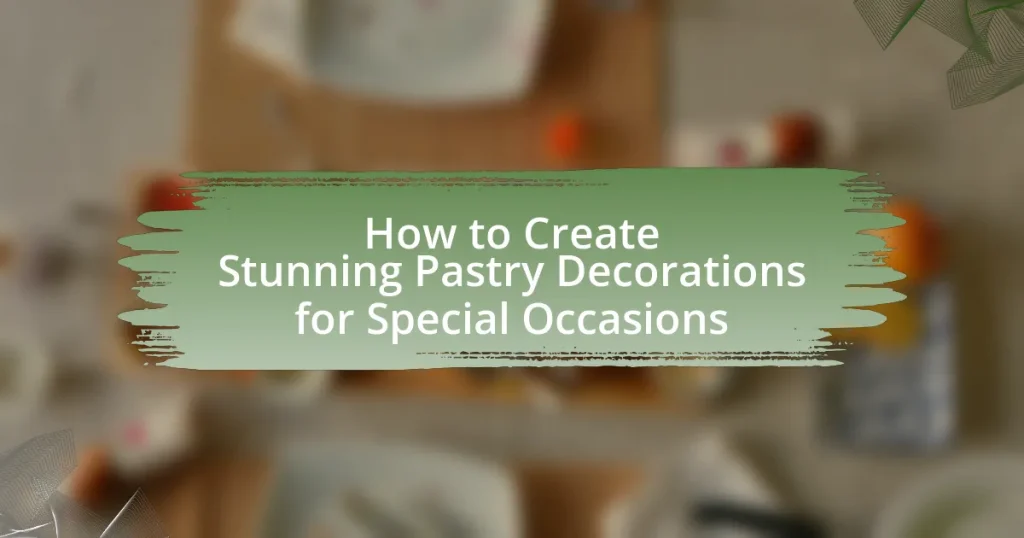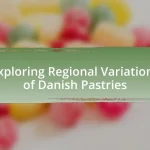The article focuses on essential techniques for creating stunning pastry decorations for special occasions, emphasizing methods such as piping, glazing, and the use of edible embellishments. It outlines the importance of mastering basic pastry skills to enhance decoration quality and details fundamental techniques every pastry decorator should master. The article also discusses how different pastry types influence decoration methods, the necessary tools and materials, and how to tailor decorations for specific themes and events. Additionally, it covers advanced techniques, common mistakes to avoid, and tips for achieving visually appealing results, ensuring that pastries are not only delicious but also captivating in presentation.
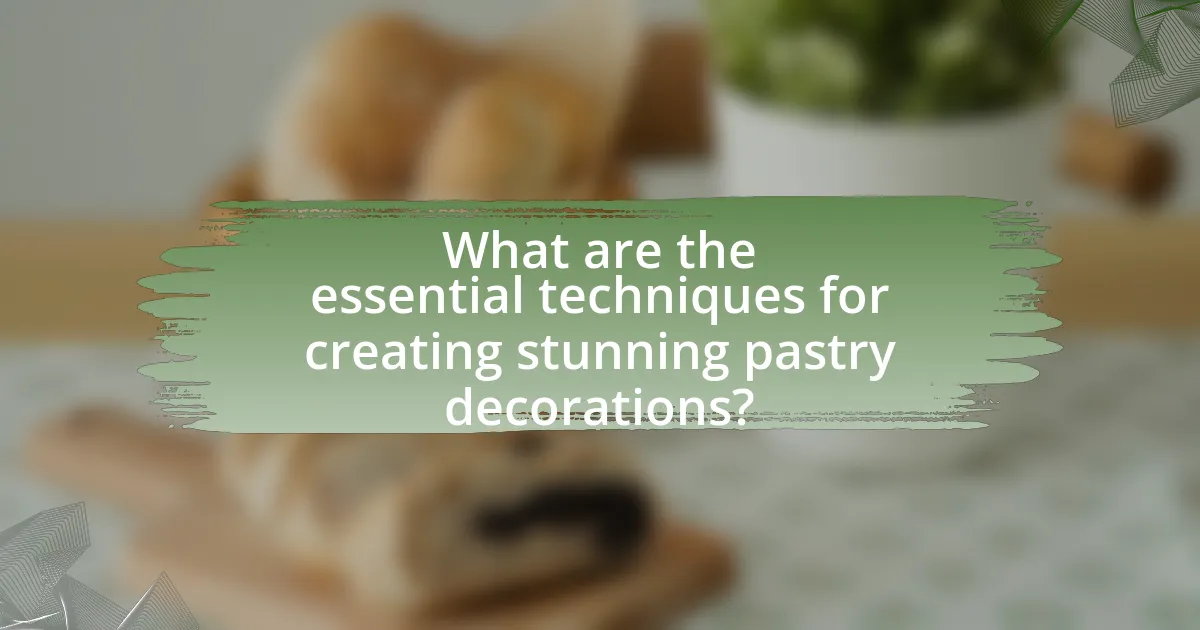
What are the essential techniques for creating stunning pastry decorations?
The essential techniques for creating stunning pastry decorations include piping, glazing, and using edible embellishments. Piping involves using a pastry bag to create intricate designs with icing or chocolate, allowing for detailed patterns and textures. Glazing, often done with a shiny fruit or chocolate glaze, enhances the visual appeal and adds a professional finish to pastries. Edible embellishments, such as fresh fruits, edible flowers, or chocolate shavings, provide color and texture, making the decoration more visually striking. These techniques are widely used by professional pastry chefs to elevate the presentation of desserts, ensuring they are not only delicious but also visually captivating.
How can basic pastry skills enhance decoration quality?
Basic pastry skills enhance decoration quality by providing a foundational understanding of techniques and materials used in pastry art. Mastery of skills such as dough preparation, piping, and glazing allows for more precise and aesthetically pleasing decorations. For instance, knowing how to properly pipe icing can lead to cleaner lines and more intricate designs, which are essential for visually appealing pastries. Additionally, understanding the properties of different ingredients, like chocolate or fondant, enables decorators to create textures and finishes that elevate the overall presentation. This knowledge is supported by culinary education programs that emphasize the importance of technique in achieving high-quality pastry decorations.
What fundamental techniques should every pastry decorator master?
Every pastry decorator should master techniques such as piping, fondant application, and glazing. Piping involves using a pastry bag to create intricate designs and borders, which is essential for adding detail to cakes and pastries. Fondant application requires skill in rolling and smoothing the fondant over cakes to achieve a polished look, a technique widely used in professional cake decorating. Glazing, which involves applying a shiny coating to pastries, enhances visual appeal and can improve texture. Mastery of these techniques is supported by their prevalence in professional pastry arts, as evidenced by their inclusion in culinary school curricula and industry standards.
How do different pastry types influence decoration methods?
Different pastry types significantly influence decoration methods due to their unique textures, structures, and moisture levels. For instance, delicate pastries like puff pastry require light, airy decorations such as whipped cream or fruit glazes, which complement their flaky layers. In contrast, denser pastries like pound cake can support heavier decorations, such as fondant or buttercream, allowing for more intricate designs. Additionally, pastries with a moist crumb, like sponge cake, benefit from decorations that enhance their softness, such as ganache or mousse, which can be easily spread or piped. These variations in pastry characteristics dictate the choice of decoration techniques, ensuring that the final presentation aligns with the pastry’s inherent qualities.
What tools and materials are necessary for pastry decoration?
Essential tools and materials for pastry decoration include piping bags, various piping tips, offset spatulas, food coloring, fondant, edible glitter, and stencils. Piping bags allow for precise application of icing and cream, while different piping tips create various decorative effects. Offset spatulas are crucial for smoothing and spreading frosting. Food coloring enables customization of icing shades, and fondant provides a smooth surface for intricate designs. Edible glitter adds sparkle, and stencils help achieve consistent patterns. These tools and materials are widely used in professional and home baking to enhance the visual appeal of pastries.
Which essential tools should every pastry decorator have?
Every pastry decorator should have a set of essential tools that include a piping bag, various piping tips, a bench scraper, offset spatula, and a turntable. These tools are crucial for creating intricate designs and achieving professional results in pastry decoration. The piping bag allows for precise application of icing and fillings, while different piping tips enable decorators to create various textures and shapes. A bench scraper is useful for smoothing edges and cutting dough, an offset spatula helps in spreading icing evenly, and a turntable facilitates easy access to all sides of the pastry during decoration. Collectively, these tools enhance the decorator’s ability to produce visually appealing and expertly crafted pastries.
What types of edible materials can be used for decoration?
Edible materials used for decoration include fondant, royal icing, chocolate, edible glitter, fruit, nuts, and edible flowers. Fondant is a pliable sugar dough that can be shaped into various designs, while royal icing is a stiff icing made from egg whites and powdered sugar, ideal for intricate piping. Chocolate can be molded or tempered to create decorative elements. Edible glitter adds sparkle, and fresh fruit or nuts can enhance both appearance and flavor. Edible flowers, such as pansies or violets, provide a natural aesthetic. These materials are commonly utilized in pastry decoration to enhance visual appeal and are safe for consumption.
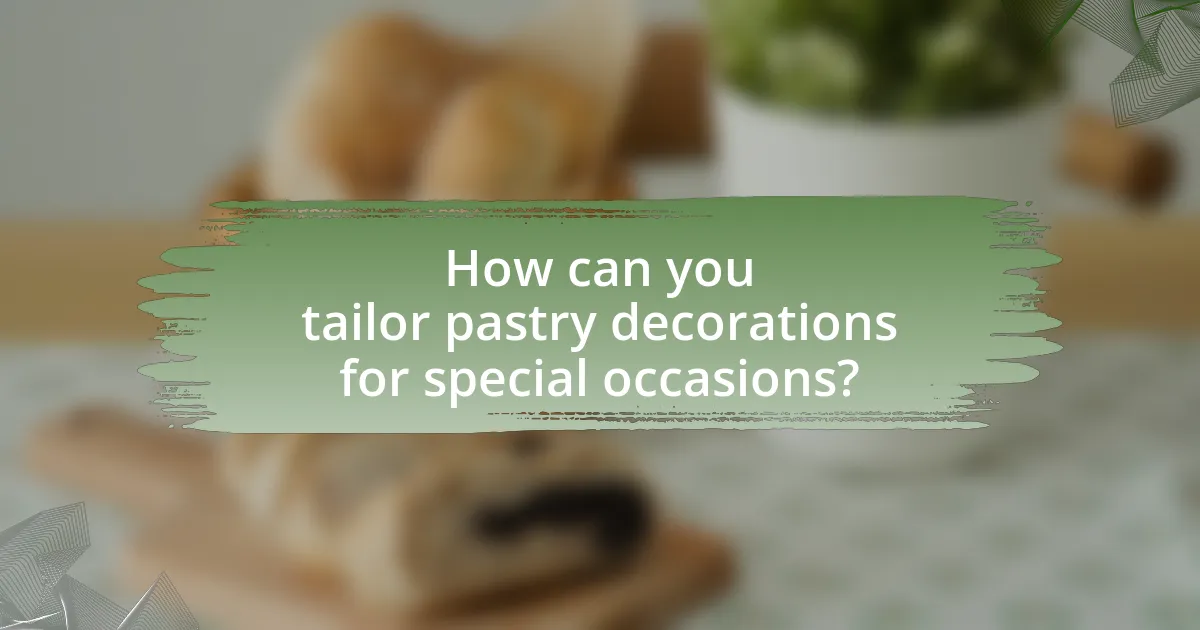
How can you tailor pastry decorations for special occasions?
To tailor pastry decorations for special occasions, customize designs based on the event’s theme, colors, and symbols. For example, use floral patterns for weddings, seasonal motifs for holidays, or specific colors that match the celebration. Incorporating personalized elements, such as monograms or age numbers, enhances the significance of the pastry. Additionally, utilizing techniques like fondant sculpting, edible glitter, or airbrushing can elevate the visual appeal, making the pastries more memorable. These methods are widely recognized in the culinary arts for their effectiveness in creating visually stunning and contextually relevant decorations.
What themes can inspire pastry decorations for events?
Themes that can inspire pastry decorations for events include seasonal motifs, such as autumn leaves or winter snowflakes, and celebratory themes like birthdays or weddings featuring floral designs. Seasonal motifs allow for the incorporation of colors and elements that reflect the time of year, enhancing the visual appeal of pastries. Celebratory themes often utilize symbols associated with the occasion, such as cake toppers or edible decorations that represent the event’s significance. For example, a wedding theme may include intricate sugar flowers or monogrammed designs, while a birthday theme might feature vibrant colors and playful shapes. These themes not only guide the aesthetic choices but also resonate with the event’s atmosphere, making the pastries a focal point of celebration.
How do seasonal themes affect decoration choices?
Seasonal themes significantly influence decoration choices by dictating color palettes, motifs, and materials used in design. For instance, during autumn, warm colors like orange and brown are prevalent, while winter often features cool tones such as blue and white, reflecting the seasonal atmosphere. Additionally, specific motifs like pumpkins in fall or snowflakes in winter guide the selection of decorative elements. Research indicates that consumers are more likely to engage with decorations that resonate with seasonal themes, enhancing their emotional connection to the occasion. This alignment with seasonal aesthetics not only elevates the visual appeal but also creates a cohesive experience that resonates with the audience.
What are some popular themes for weddings and birthdays?
Popular themes for weddings include rustic, vintage, beach, and garden, while popular themes for birthdays often feature tropical, superhero, and elegant styles. The rustic theme emphasizes natural elements and simplicity, appealing to couples seeking a cozy atmosphere. Vintage themes draw inspiration from past eras, often incorporating antique decor. Beach themes focus on coastal elements, perfect for seaside ceremonies. Garden themes utilize floral arrangements and greenery, creating a romantic setting. For birthdays, tropical themes use vibrant colors and exotic decorations, while superhero themes cater to fans of comic book characters. Elegant styles prioritize sophistication with refined color palettes and upscale decor. These themes are widely recognized and frequently chosen for their ability to create memorable experiences.
How can color and texture enhance pastry decorations?
Color and texture significantly enhance pastry decorations by creating visual appeal and stimulating sensory experiences. The use of vibrant colors can attract attention and evoke emotions, while varied textures, such as smooth glazes or crunchy toppings, add depth and interest. Research indicates that color influences perception; for example, studies show that people associate certain colors with flavors, impacting their overall enjoyment of the pastry. Additionally, contrasting textures can enhance the eating experience, as textures like creamy fillings paired with crispy crusts create a more dynamic and satisfying bite.
What color combinations work best for specific occasions?
For weddings, soft pastels like blush pink and ivory create an elegant atmosphere. Birthdays often benefit from vibrant combinations such as bright blue and yellow, which evoke joy and celebration. For holidays, red and green are traditional for Christmas, symbolizing festivity and warmth. Corporate events typically favor neutral tones like gray and navy, projecting professionalism and sophistication. Each of these combinations aligns with the emotional tone and cultural significance of the occasion, enhancing the overall aesthetic of pastry decorations.
How does texture play a role in visual appeal?
Texture significantly enhances visual appeal by adding depth and interest to the overall presentation. In pastry decoration, varied textures can create contrast, making elements stand out and inviting closer inspection. For instance, a glossy glaze juxtaposed with a rough, crumbly topping can draw the eye and stimulate curiosity, leading to a more engaging visual experience. Research indicates that textures can influence perception; a study published in the journal “Food Quality and Preference” found that consumers rated products with diverse textures as more appealing, demonstrating the importance of texture in attracting attention and enhancing aesthetic enjoyment.
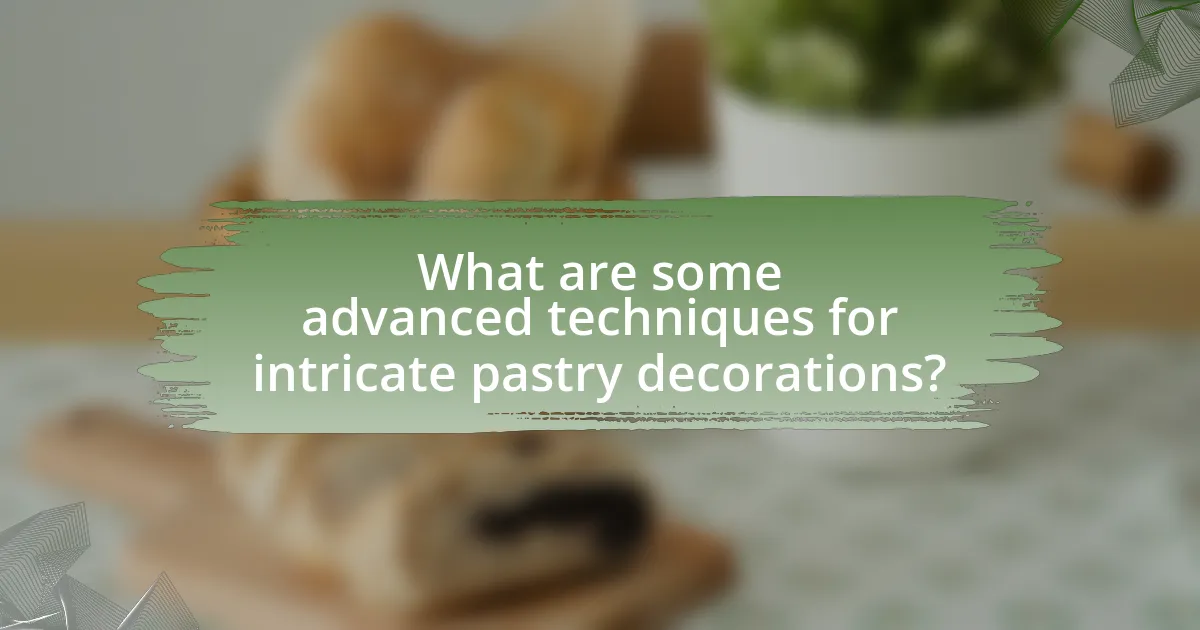
What are some advanced techniques for intricate pastry decorations?
Advanced techniques for intricate pastry decorations include sugar work, chocolate tempering, and airbrushing. Sugar work involves creating delicate structures like spun sugar or sugar flowers, which add elegance to pastries. Chocolate tempering allows for the creation of shiny, stable chocolate decorations such as curls, shards, and molded shapes, enhancing both flavor and presentation. Airbrushing enables precise color application and intricate designs on pastries, providing a professional finish. These techniques are widely used by pastry chefs to elevate the aesthetic appeal of desserts, making them suitable for special occasions.
How can you use fondant and gum paste effectively?
To use fondant and gum paste effectively, roll them out to a uniform thickness for smooth application on cakes and pastries. Fondant is ideal for covering cakes due to its pliability and ability to create a sleek finish, while gum paste is better suited for intricate decorations like flowers because it dries hard and can hold fine details. For best results, ensure both mediums are properly kneaded and conditioned before use, as this enhances their workability. Additionally, using cornstarch or powdered sugar prevents sticking during rolling and shaping, which is crucial for achieving clean edges and professional-looking designs.
What are the steps to create detailed fondant decorations?
To create detailed fondant decorations, follow these steps: first, prepare the fondant by kneading it until smooth and pliable. Next, roll out the fondant to the desired thickness using a rolling pin, ensuring an even surface. Then, use cookie cutters or molds to cut out shapes, and apply food coloring or edible dust for added detail. After shaping, allow the decorations to dry for a few hours to harden. Finally, attach the decorations to your pastry using a small amount of water or edible glue. These steps ensure that the fondant decorations are not only visually appealing but also stable for presentation.
How can gum paste be shaped into realistic figures?
Gum paste can be shaped into realistic figures by using specific techniques such as modeling, sculpting, and detailing. To achieve lifelike results, artists often start by conditioning the gum paste to make it pliable, then use tools like sculpting knives, ball tools, and veining tools to create intricate details. Additionally, incorporating edible colors and dusts enhances realism by adding depth and texture. The use of reference images for proportions and features further aids in achieving accuracy, as seen in professional cake decorating practices where attention to detail is crucial for lifelike representations.
What role does airbrushing play in pastry decoration?
Airbrushing plays a crucial role in pastry decoration by allowing for precise application of color and effects on desserts. This technique enables pastry chefs to create intricate designs, gradients, and textures that enhance the visual appeal of pastries. Airbrushing can be used to apply edible colors uniformly, achieving a professional finish that is difficult to replicate with traditional methods. The use of airbrushes in pastry decoration has been widely adopted in the industry, as it allows for creativity and customization, making desserts more attractive for special occasions.
How can airbrushing techniques elevate your designs?
Airbrushing techniques can elevate your designs by providing a smooth, even application of color that enhances depth and dimension. This method allows for intricate detailing and gradients that are difficult to achieve with traditional decorating methods. For instance, airbrushing can create realistic textures and shadows on pastry surfaces, making them visually striking and appealing. Additionally, airbrushing enables the use of edible colors that can be blended seamlessly, resulting in a polished finish that captures attention. The precision of airbrushing also allows for customization, enabling designers to match specific themes or color palettes for special occasions, thereby increasing the overall aesthetic value of the pastry decorations.
What are the best practices for using an airbrush on pastries?
The best practices for using an airbrush on pastries include ensuring proper air pressure, using food-safe colors, and maintaining a consistent distance from the surface. Proper air pressure, typically between 15 to 30 psi, allows for even application without oversaturation. Food-safe colors, such as those specifically designed for airbrushing, ensure that the decorations are safe for consumption. Maintaining a distance of 6 to 12 inches from the pastry surface prevents pooling and allows for a fine mist, resulting in a smooth finish. These practices enhance the visual appeal of pastries while ensuring safety and quality.
What are some common mistakes to avoid in pastry decoration?
Common mistakes to avoid in pastry decoration include neglecting to plan the design, using the wrong tools, and not allowing components to cool properly. Failing to plan can lead to a disorganized appearance, while using inappropriate tools can result in uneven or messy decorations. Additionally, not allowing pastry components to cool can cause melting or smudging of decorations, compromising the overall aesthetic. These mistakes can detract from the visual appeal of the pastry, making it less impressive for special occasions.
How can over-decorating affect the overall presentation?
Over-decorating can detrimentally impact the overall presentation by overwhelming the viewer and obscuring the main features of the pastry. When excessive decorations are applied, they can create visual clutter, making it difficult for the audience to appreciate the craftsmanship and flavors of the pastry itself. Research indicates that a balanced design enhances aesthetic appeal, while overloading with elements can lead to confusion and a lack of focus on the primary subject. For instance, studies in design psychology show that simplicity often leads to higher satisfaction and engagement, reinforcing the idea that moderation in decoration is key to effective presentation.
What are the pitfalls of using the wrong materials?
Using the wrong materials in pastry decoration can lead to poor aesthetic results and compromised taste. For instance, using low-quality chocolate can result in a dull appearance and undesirable texture, while incorrect food coloring may cause fading or unnatural hues. Additionally, improper fondant can crack or tear, ruining the overall presentation. These issues not only affect the visual appeal but can also diminish the overall quality of the pastry, leading to customer dissatisfaction.
What tips can help you create stunning pastry decorations?
To create stunning pastry decorations, focus on precision, creativity, and the right tools. Use sharp, clean tools for cutting and shaping, as this ensures clean edges and professional-looking designs. Incorporate vibrant colors through natural food dyes or high-quality fondants, which can enhance visual appeal. Additionally, practice techniques such as piping, stenciling, and layering to add texture and depth to your decorations. For instance, mastering the art of piping can allow for intricate designs that elevate the overall presentation. These methods are supported by culinary experts who emphasize the importance of technique and presentation in pastry decoration.
How can planning and practice improve your decoration skills?
Planning and practice significantly enhance decoration skills by providing structure and opportunities for refinement. When individuals plan their decoration projects, they can outline specific techniques, materials, and styles to focus on, which leads to more organized and effective execution. For instance, a study published in the Journal of Educational Psychology indicates that deliberate practice, which includes planning and repetitive execution, is essential for mastering complex skills, such as pastry decoration. This structured approach allows decorators to identify areas for improvement and develop their unique style over time, ultimately resulting in more visually appealing and professional-looking decorations.
What are some quick fixes for common decoration issues?
Quick fixes for common decoration issues in pastry include using edible glitter to cover imperfections, applying a thin layer of ganache to smooth out uneven surfaces, and utilizing fresh fruits or edible flowers to enhance visual appeal. Edible glitter effectively distracts from flaws, while ganache not only improves texture but also adds richness. Fresh fruits and flowers provide vibrant colors and natural beauty, making the overall presentation more appealing. These methods are widely used by pastry chefs to quickly elevate the aesthetic quality of their creations.
